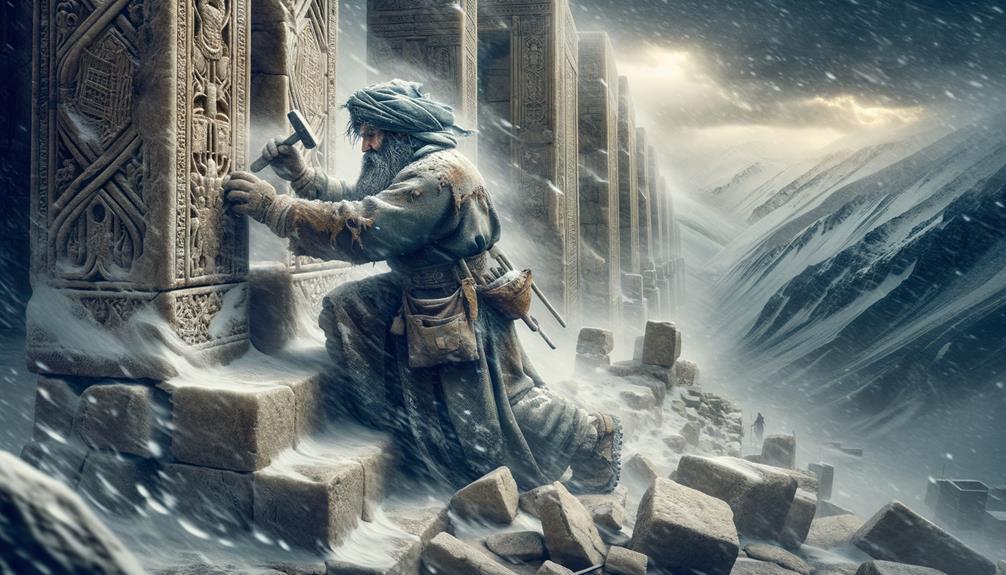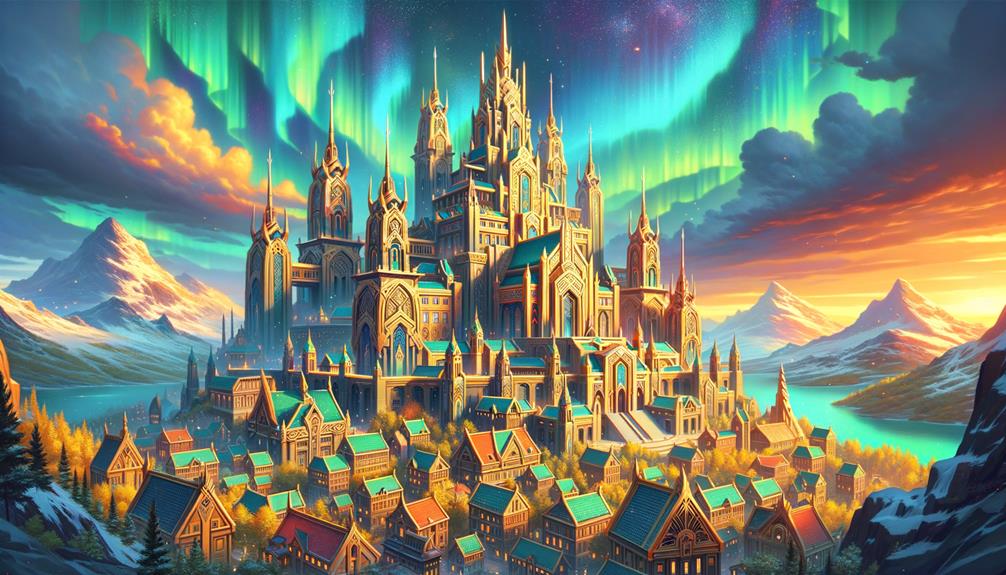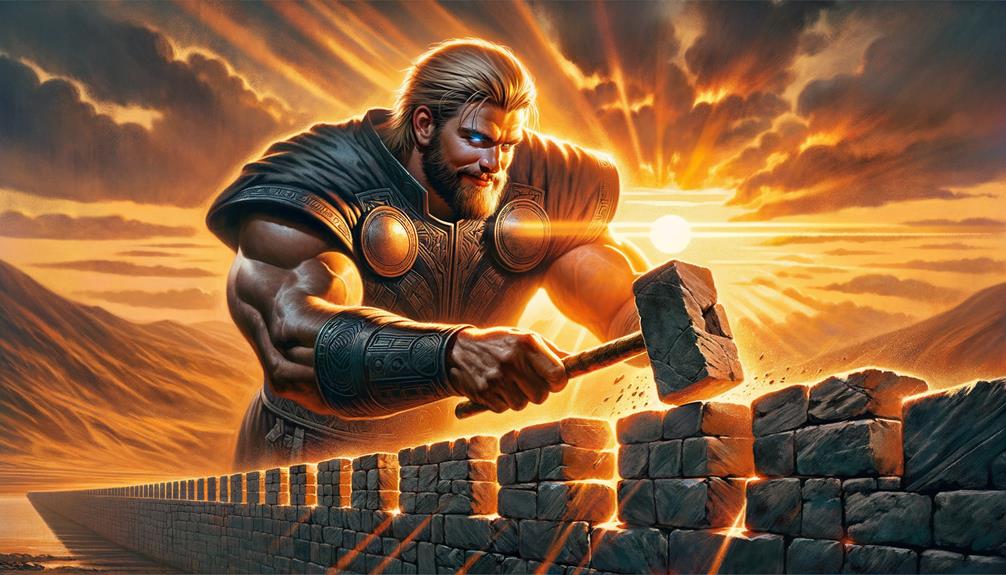Asgard's lore spins a fascinating tale about Hrimthur, the crafty giant mason who fooled the gods into strengthening their city in the face of Ragnarok's looming threat. Making use of earthly stones and enigmatic crystals, he carved protective runes that not only boosted Asgard's defenses but amplified its celestial beauty as well.
His craftmanship reflected time-honored stone-working techniques, transforming them into metaphysical barriers. However, his wall also hinted at Asgard's vulnerability, subtly suggesting the unavoidable Ragnarok. Hrimthur's fortifications might have been a premonition of the recurring cycle of creation and destruction. But don't you think there's more to dig up about his masonry techniques, the materials used, and the hidden symbolism? Well, the legend is still unfolding.
Asgard Giant Mason: Historical Overview
Let's get chatty about Hrimthur, the clever giant stonemason. He put together a plan to trick the gods of Asgard into believing he was building a wall to protect them. The gods, so sure of themselves, welcomed this idea. Odin, the Allfather, thought it was impossible for Hrimthur to finish the wall within the deadline. Unknown to Odin, this belief was what Hrimthur was counting on. This set the stage for the predicted Ragnarok.
The wall wasn't just a wall. It was a symbol of how vulnerable Asgard really was – something Freya hinted at. When Hrimthur completed the Great Wall of Jötunheim, it started a chain reaction that led to Asgard's doom. The fiery Surtr took down Asgard during the ill-fated Ragnarok.
Techniques in Masonry Fortification

Let's delve into the fascinating story of Hrimthur's crafty scheme, shall we? It's truly a testament to his skill in masonry. This giant mason, with his exceptional talent, employed certain methods like fitting stones together like puzzle pieces and laying rock-solid bases. It's pretty similar to how the old-time builders ensured their strongholds stood the test of time. Carefully carving and fitting each stone is a reminder of how every action and decision we make should be thoughtfully considered. Hrimthur's thoughtful inclusion of protective elements, such as towers and walls, shows his ability to look ahead and plan for the unexpected. It serves as a reminder that whatever we create, we should always be ready for unforeseen challenges. So, in essence, the giant mason's methods aren't just about building forts—they're lessons in how to approach life.
Materials Used in Asgard's Reinforcement

Let's chat about the materials that Hrimthur used to beef up Asgard's defenses. He didn't just utilize any old stone blocks; he chose enormous ones, sourced straight from the core of Jötunheim. These weren't just for physical safety, they were a testament to Asgard's rock-solid strength and grit. With protective runes etched into them, these stones offered more than just a physical barrier; they served as a metaphysical guard against any would-be intruders, a nod to age-old stonemasonry skills passed down from one generation to the next.
The mixture of earth, clay, and sacred herbs that was part of the foundation wasn't just a building material. It symbolized the bond between Asgard and nature, adding to the wall's sturdiness. Then there were the magical crystals, filled with protective spells, and incorporated into the wall. These weren't just for show; they were a mystical defense mechanism, signifying Asgard's strong ties with the mysterious and unexplainable.
Challenges in Preserving Ancient Structures

When I look at these age-old buildings, the impact of time is clear on their once grand exteriors. It's a never-ending struggle, like a superhero endlessly battling villains, to stop these architectural wonders from falling victim to the elements. The task of preservation is a balance between using cutting-edge technology and time-honoured methods, a process that's reminiscent of artfully blending old and new strands in a tapestry.
Structural Degradation Over Time
The Great Wall of Jötunheim, much like other ancient structures, has been grappling with the natural effects of weather, earthquakes, and erosion over time. It's a fascinating interaction between nature and man-made creations. With each passing year, there's a noticeable shift, a transformation, if you will. Structures are built, only to be slowly taken apart by the elements, mirroring the cyclical nature of life itself.
Take a look at the ancient walls of Jötunheim, for instance. What was once a formidable fortification now bears the undeniable signs of age. The weathered ramparts and eroded stones are a testament to their enduring battle against nature's relentless forces. It's a silent nod to their past glory and a reminder of the inherent strength of our ancestors' craftsmanship.
But it also serves as a poignant symbol of the passage of time. No matter how grand or sturdy, every structure eventually gives in to the slow churn of time. It's not a defeat, though. Rather, it's a testament to the timelessness of these creations. Even in their worn state, they continue to inspire awe and admiration, standing as enduring symbols of our shared history.
Restorative Techniques for Antiquity
There's no denying the rich history and symbolic importance of ancient structures. However, we must also consider the challenges involved in maintaining these age-old monuments. Let's take a fun turn and try to understand this through the lens of Norse Mythology. You can think of the durability of these structures as Asgard's Giant Mason – always under attack from the environment and time, and always in need of some TLC.
Let's break it down:
| Challenges | Norse Mythology Equivalent |
|---|---|
| Keeping the Building Up | Asgard's Giant Mason |
| Dealing with Wear and Tear | Material's Ragnarok |
| Weather Effects | Thor's Thunder |
| Damage from People | Loki's Mischief |
This comparison helps us understand the tireless work of conservators a bit better. They're sort of like Heimdall, always on guard for our cultural heritage, using various preservation techniques to keep these valuable pieces of history intact. Recognizing their efforts, we can genuinely grasp the enormity of their job.
Impact of Fortification on Asgard's Aesthetics

When we look at the influence of fortification on the looks of Asgard, it's hard to ignore the fact that the massive wall, crafted by a giant mason, ended up doing more than just upping its defenses. It also played a key role in boosting the city's majestic charm, a charm that's deeply tied to Norse mythology.
- The wall, encircling Asgard, was a sign of an end to the long, harsh winter and the beginning of a time of renewal. It's a bit like the goddess Freya, who was famous for her stunning beauty and her connection to fertility.
- It wasn't just a wall – it was a symbol of the Aesir's might, a might that was reminiscent of the unyielding spirit of Viking warriors.
- The detailed masonry was a testament to the skill of the giant craftsman, a reflection of the city's divine character.
Long-Term Benefits of Asgard's Fortification

Without a doubt, the giant mason's work on Asgard's fortification was more than just an impressive display of architecture. It was a calculated decision, one that ensured the city's safety from potential dangers for years to come. The Aesir Gods, with their wisdom, recognized the importance of a robust defense. They knew that finishing the wall was the equivalent of sealing a deal, so they made sure the project was completed.
| Benefit | Symbolic Understanding | Comparative Analysis |
|---|---|---|
| Improved Security | The wall of Asgard: a symbol of safeguarding | More robust than defenses in other realms |
| Aesir's Stronghold | Showcases the power of Aesir Gods | More dominant than other cosmic beings |
| Long-lasting Safety | Reveals the Gods' foresight | Outperforms temporary solutions |
| Defense for Generations | Denotes enduring legacy | Lasts longer than short-lived victories |
| Significant Achievement | Marks a historical milestone | Surpasses previous undertakings |
Consequently, this fortification not only represented physical strength but also embodied the wisdom and foresight of the Aesir Gods.
Frequently Asked Questions
What Is the Fortification of Asgard in Norse Mythology?
In the tales of Norse mythology, the fortification of Asgard is something quite remarkable. You see, Asgard isn't just surrounded by a simple wall. No, it's much more than that. The fortification of this place is a mythical marvel, a testament to the might and majesty of the Aesir gods. It's a tangible symbol of protection, a grand statement of their power. It truly is an awe-inspiring sight to behold.
Was Loki Pregnant With Sleipnir?
Indeed, in Norse mythology, Loki underwent a transformation into a mare which led to him becoming pregnant with Sleipnir. The significance of Sleipnir is anchored in his distinct nature and the role he plays within the introspective tales of Norse pregnancy folklore.
Who Was the Giant That Built the Wall of Asgard?
So, let's chat about the giant who was behind the construction of Asgard's wall, shall we? His name was Hrimthur, and interestingly enough, he was driven by a desire for payback against the Aesir Gods. He cleverly took advantage of Asgard's weak points by using his knowledge of mythical construction. Believe it or not, Odin, the head honcho himself, didn't see this clever strategy coming.
What Does the Stranger Want as Payment for Building Defensive Walls for Asgard?
This stranger isn't asking for your typical payment. Instead, he's got a pretty unconventional request. His price for constructing Asgard's walls? Freya, the sun, and the moon. You heard that right. It's not some small change we're talking about here but the very elements that govern life. It's clear from his demands, this isn't any ordinary deal.


